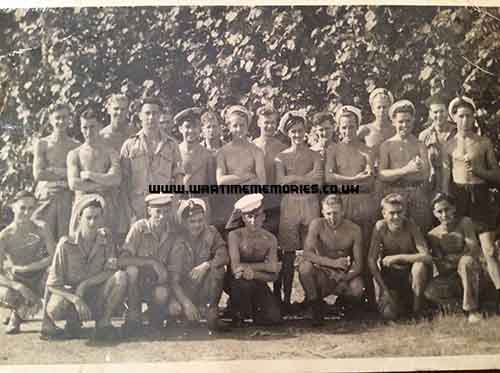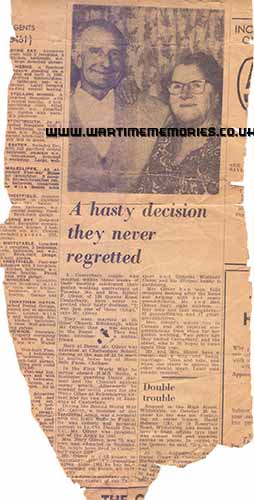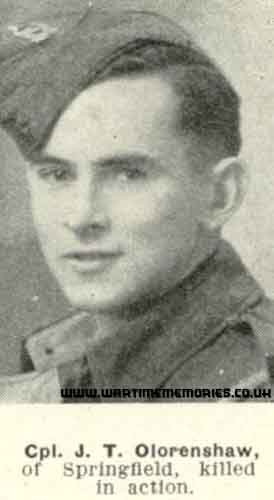Cpl. John Turner Olorenshaw . New Zealand Army 26th Btn. from Springfield, Canterbury, New Zealand (d.11th Aug 1944) John Turner Olorenshaw was born on 31 December 1921, in Christchurch, New Zealand; son of Percy Olorenshaw and Bertha Fanny (nee Turner), both born in England. Percy had emigrated to New Zealand in 1910, following his elder brother, Charlie.
Percy was a farmer, in Springfield, Canterbury, NZ, and John worked on the farm with him as a ‘mixed farm hand’.
John attested on 17 April 1941 in Christchurch, and on 1 July 1941 was posted to ‘C’ Company, 2nd Canterbury Regiment. He was 19 years and 107 days old.
John was educated to Standard VI, had a license to drive an ‘ordinary’ motor vehicle, could ride a horse, and could supply a horse (though initially he indicated that he couldn’t, this was crossed out to say that he could). His preference for military service was the Cavalry.
On 21 November 1942, he was posted to 9th Battalion Reinforcements.
On 19 April 1943, John was posted to 2/NZEF Reinforcements, A Battalion, B Barracks, and on 14 May embarked from Wellington to Egypt, arriving on 11 June 1943 when he was posted to the 33rd Battalion X (IV). On 19 June, he was promoted to Lance Corporal/Temporary Corporal.
On 10 July, he was posted with other reinforcements to 26th Battalion, where he remained for the rest of his service. The 26th Battalion had been heavily involved in fighting in both Greece and the Desert campaign, and John was part of much needed reinforcements to boost severely depleted numbers. During his time in the desert, he was based at Maadi Camp, and underwent further, more intensive training in preparation for service in the European theatre. He was promoted to Corporal on 20 July.
On 15 September 1943, the Battalion moved to Burg el Arab, on a bus, then a 7 day march (at night), with the last leg by lorry from Amiriya. They arrived late at night and were greeted by as much hot tea as they could drink, then set up their bivouacs before finally retiring well after midnight. At Burg el Arab, they underwent further training, until on 3 October they were moved to Amiriya, in preparation for embarkation. Early on 5 October, the Battalion moved to Alexandria docks and were gradually ferried in barges to their ships – the Dunattar Castle, the Reinadel Pacifico and the Sabijak. The convoy sailed later that day, escorted by 5 destroyers of the Royal Greek Navy.
The shores of Italy were sighted on 9 October 1943, and the troops disembarked at Taranto, setting up camp on the outskirts. Here, they settled into their bivouacs, underwent further training, and not a little recreation, but were plagued from the end of October by heavy rain and flooding. This was to be a regular hazard over the coming months, often washing over the camps, tents, clothes, and sometimes preventing military plans. What made this even worse was that, for the first few months, it was very, very cold.
On 13 November 1943, the Battalion was moved towards the front lines, stopping at a staging camp for the Adriatic Front, 160 miles from Taranto. The journey there, as anywhere at the time, was incident-prone, either due to weather, enemy attacks, or destruction of roads and bridges. (November 6 had again seen torrential rain which lasted for 4 days, and nearly washed them all away.)
At just after 8.00am on 13 November, they were loaded onto lorries and driven along the coastal road towards Lucera. By 12.30pm, they were about half way there, and stopped to bivouac until the next day. They continued on 14 November, but made much slower progress as the Germans had destroyed the bridge. They passed through Lucera shortly after noon, and at 1.30pm reached La Torre, where they bivouacked (only to be flooded again on the 14th and 15th).
At 8.15am on 17 November, the Battalion was transported to relieve the 8th Indian Division on the Adriatic Front, on the south bank of the Sangro river. The trip was 107 miles, passing through Termoli then onto Gissi, where they spent the night, only stopping when it was well past 2.00am. They slept in the trucks or on the open ground. Four hours later, the journey resumed. Early in the afternoon on the 18th, they arrived at the Osento River. Alternative means of crossing had to be found, as the Germans had blown the bridge, and it took till 1.00am for them to move all personnel to their camp site, in the river bed. A few hours later, they marched another 6 miles over the hills to the new sector. The new camp was 4 miles from the Sangro, and they remained under cover for the rest of the day. At 5.00pm they marched again, to the Sangro, taking up positions and digging in at 7.30pm, completing their defensive position by 11.00pm. They held a 300 yard front. During the following days, they suffered sporadic shelling, and probing of enemy patrols. However, this was relatively light.
The planned attack was delayed when, on 20th November, the river flooded. By 27th November, water levels had reduced enough to allow the attack to be launched. It commenced with a bombardment at 2.45am. All the men, including the tallest, struggled in crossing the still raging river, which was not only raging with water, but also with boulders. Castelfrentano was captured on 1 December, ending the first phase of the attack across the Sangro. The battle of Sangro-Orsogna lasted from 27 November to 2 December 1943. In general, only light resistance was offered by the Germans, who had already determined that they would set up a defensive ‘Winter Line’ further back, from Guardiacrels, via Orsogna, to Ariell and Ortona.
The victorious troops of 26th Battalion assembled in Castelfrentano, with Orsogna just 4 miles away. At 7.00am on 3 December, they marched off down Route 84, in reserve to the forces attacking the German’s Winter Line.
The new campaign against this line proved much more difficult. Attacks were launched and repulsed, troops dug in to consider options, German artillery bombardment was more intense. The weather was terrible. The only plus was that there was little seen or heard from the Lufwaffe. On 7 December, they again moved forwards and at 1.00pm attacked. Again they failed, but held position on the Brecciarola Ridge, still under attack by the enemy. Only 16th December seems to have been a quieter day. On the night of 18/19 December, they were relieved, and returned to Castelfrentano, just to the rear. December 21 saw the Battalion marching the 7 miles back to the front lines, in reserve.
On 24 December, they carried out a successful attack on Fontegrande Ridge, west of the Orsogna-Urtona road, then consolidated their new position. Christmas Day was fairly quiet – the morning produced a few exchanges of fire, though in the afternoon German troops began to move up towards them. A barrage of mortar-fire stopped the threat.
New Years Eve saw heavy snow, bringing 3 to 4 feet deep drifts.
On 2 January 1944, they were relieved, and returned again to Castelfrentano. They expected to have to return to the line, but on the 12th were told they were being withdrawn for a rest. Just before midnight on 14th January, the Battalion set off towards Lucera. Shortly before reaching there, they were diverted – towards the lines on the west side of the Apennines. On the morning of 16th January, they moved off towards Naples, reaching camp in the valley of the Volturno river (near Alife and Raviscanina) on the 17th. They bivouacked there until 5 February, when at 10.30pm they ‘embussed’, arriving at the lines of the Rapido river 2 ½ hours later. They were now 6 miles from Cassino. On 21 February, they began to move up, arriving at their lines on 22nd. The next couple of days were taken up with reconnaissance. Attack was planned for 24 February, however, just for a change, it rained in torrents. It was over 2 weeks before the weather cleared. The attack began at 5.25pm on 15 March 1944. They were there, constantly in heavy action, for 19 days. After this protracted period of action, which had not got them far, they were pulled back 18 miles for a well deserved rest.
April 12th found them moving again to the attack lines of Cassino, but this time to a quieter area near Mount Croce. They moved to Folignano initially, 21 miles away, then onwards into battle.
On 20 April, they were relieved, retiring to the north end of Volturno Valley.
May 1st, and they were on their way to Acquafondata, starting at 1.00pm. After dark, they marched 3 miles to the foot of the Terelle Road, then the next day climbed for 3 hours up the steep mountain side to Battalion HQ – where they found much loud activity. Here they stayed until the night of 17/18 May, when they moved back to the banks of the Volturno.
27 May, and they were on their way again to Folignano, 12 miles from camp. On the afternoon of 28th, they continued to La Selva, where they dug in for a few days, before moving on to the staging area near Atina on 31 May. However, before reaching here, they discovered their time on the lines at Cassino was at an end, and they were being redirected to another area, 5 miles south of Sora. On the way there, on 1 June, they were heavily shelled and scattered from the vehicles, deciding to stop just where they were and settle in for the night. On 2 June, they moved in to Sora. On 3 June, at 9.30pm, they travelled the 9 miles towards Balsorano, where they dug in behind the 24th Battalion. Here, German troops were vigorously fighting a rearguard action, protecting retreating troops. The 24th Battalion had taken a beating, and it was decided to move the 26th Battalion through them to attack the German rearguard. This was due to take place on 4 June, but the news of the fall of Rome caused the attack to be cancelled. The Battalion moved back to the reserve area, 4 miles south of Sora, arriving at 4.00am.
On 7 June 1944, they travelled to Avezzano, with the aim of clearing the rearguard parties, protecting road-repairers and helping in mine-clearing. They set off at 6.15am down the Balsorano Road, but after an hour had to continue on foot as the road had been destroyed. They eventually reached Avezzano on 10 June. On 14 June they were moved to Arce (20 miles north of Cassino), where they were to stay until 10 July, resting and training, before moving on towards a new front line, 270 miles away. At 2.00am on 10 July they embussed, stopping after dawn at a camp north of Rome. They continued that night and reached the assembly area near Lake Balsorano at 1.00am on 11 July (a few miles south of Lake Trasimene, south of Florence). The Arezzo Sector was 30 miles north of the lake, beyond Castiglion Fiorentino. At 7.00pm on 12 July, they moved up Route 71, reaching their lines by midnight – around the slopes of Mount Maggio. The plan was for them to clear the area, and make way for an armoured thrust through the town of Arezzo, to the Arno. The day of 13th July was very quite, until the evening when a German patrol bumped into a few of the dug in troops. The New Zealanders recovered from the shock first. After this, activity increased substantially, and the assault was launched on 16 July, pushing German lines back. They were pulled back to Castiglion Fiorentino, and on 22 July reached the assembly area near Castellna, about 13 miles from the main fighting.
Night moves during 24 and 25 July moved the Battalion up to plug a gap in the lines between the Pesa river and the town of San Casciano. They were to attack an arc of hills covering the approaches to Florence. By dawn of 26th they had dispersed under cover near Tavarnelle on Route 2, from where they set off to La Ripa which they cleared by 1.30am. Various Companies of the Battalion moved towards Montagnana and Cerbaia at 4.40am. Then, onto La Romula, which was taken by 30 July. On 2 August, they withdrew to Cerbaia, until 6 August, when they ‘embussed’ to Montelupo, on the Arno river front. After dark on 8 August, they moved up to a sector 4 miles south of Mantelupo. The new objective was the take the grounds of Empoli, and important centre of communications, and the initial attacks to attain this commenced on 10 August. The goals were finally achieved on 15 August.
John Turner Olorenshaw was killed in action on 11 August 1944 by a German sniper. His body was examined by the Medical Officer of ‘B’ Company at 11.25am on 12 August, who found one small puncture wound to the left chest, with a substantial ‘graze’ to the heart. A cable was sent to notify his father on 19 August. He was buried in the Florence War Cemetery, age 22, grave number VIII.F.16. A Royal message of condolence was sent to his parents on 19 August 1944, arriving on 4 September.
Following the war, John was awarded 4 medals – 1939-45 Star; Italy Star; War Medal 1939-45; and New Zealand War Service Medal. These were issued on 14 March 1950. His mother had also applied, on 5 January 1948, for the New Zealand Memorial Cross, and this was approved on 11 February, and dispatched on 27 April, after engraving.
John’s Will (made on 19 April 1943) passed probate on 26 June 1945 (the Will had been sent to Percy on 31 August 1944). Percy was sole beneficiary, and put in an application for War Service Gratuity, stating the Army pay allotment of 6/- 6d per day up to 19 November 1944 (9/- daily for living servicemen), plus a claim for the loss of his son’s labour on the farm.
The total granted for the loss of his son, was £200.
Two or three years after the end of the war, Percy visited his son’s grave in Italy.
|






